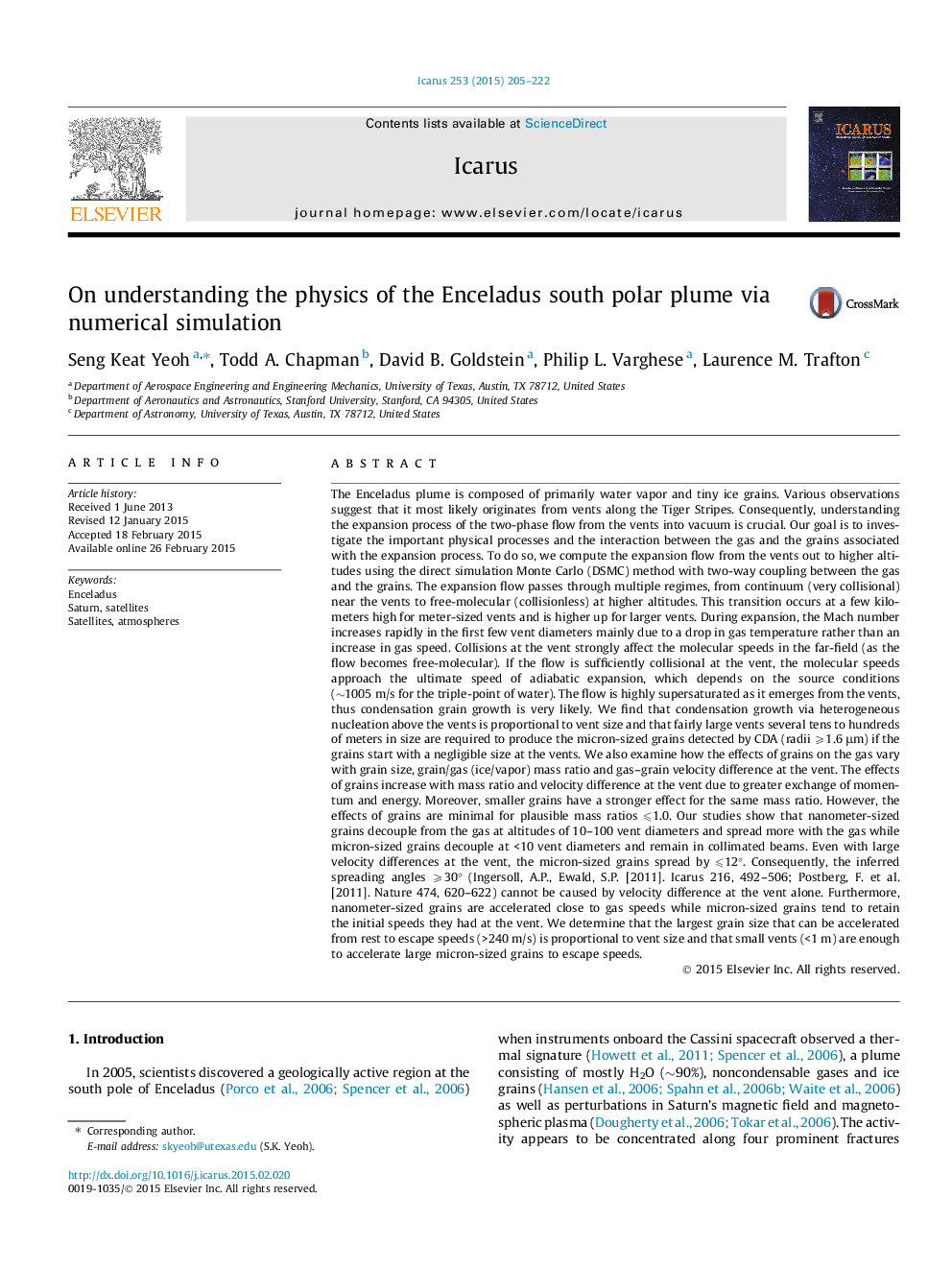| کد مقاله | کد نشریه | سال انتشار | مقاله انگلیسی | نسخه تمام متن |
|---|---|---|---|---|
| 8136460 | 1523537 | 2015 | 18 صفحه PDF | دانلود رایگان |
عنوان انگلیسی مقاله ISI
On understanding the physics of the Enceladus south polar plume via numerical simulation
ترجمه فارسی عنوان
در درک فیزیک انسلادوس قطب جنوب قطب جنوب با استفاده از شبیه سازی عددی
دانلود مقاله + سفارش ترجمه
دانلود مقاله ISI انگلیسی
رایگان برای ایرانیان
کلمات کلیدی
انسلادوس، زحل، ماهواره، ماهواره ها، اتمسفر،
موضوعات مرتبط
مهندسی و علوم پایه
علوم زمین و سیارات
علوم فضا و نجوم
چکیده انگلیسی
The Enceladus plume is composed of primarily water vapor and tiny ice grains. Various observations suggest that it most likely originates from vents along the Tiger Stripes. Consequently, understanding the expansion process of the two-phase flow from the vents into vacuum is crucial. Our goal is to investigate the important physical processes and the interaction between the gas and the grains associated with the expansion process. To do so, we compute the expansion flow from the vents out to higher altitudes using the direct simulation Monte Carlo (DSMC) method with two-way coupling between the gas and the grains. The expansion flow passes through multiple regimes, from continuum (very collisional) near the vents to free-molecular (collisionless) at higher altitudes. This transition occurs at a few kilometers high for meter-sized vents and is higher up for larger vents. During expansion, the Mach number increases rapidly in the first few vent diameters mainly due to a drop in gas temperature rather than an increase in gas speed. Collisions at the vent strongly affect the molecular speeds in the far-field (as the flow becomes free-molecular). If the flow is sufficiently collisional at the vent, the molecular speeds approach the ultimate speed of adiabatic expansion, which depends on the source conditions (â¼1005 m/s for the triple-point of water). The flow is highly supersaturated as it emerges from the vents, thus condensation grain growth is very likely. We find that condensation growth via heterogeneous nucleation above the vents is proportional to vent size and that fairly large vents several tens to hundreds of meters in size are required to produce the micron-sized grains detected by CDA (radii ⩾1.6 μm) if the grains start with a negligible size at the vents. We also examine how the effects of grains on the gas vary with grain size, grain/gas (ice/vapor) mass ratio and gas-grain velocity difference at the vent. The effects of grains increase with mass ratio and velocity difference at the vent due to greater exchange of momentum and energy. Moreover, smaller grains have a stronger effect for the same mass ratio. However, the effects of grains are minimal for plausible mass ratios ⩽1.0. Our studies show that nanometer-sized grains decouple from the gas at altitudes of 10-100 vent diameters and spread more with the gas while micron-sized grains decouple at <10 vent diameters and remain in collimated beams. Even with large velocity differences at the vent, the micron-sized grains spread by ⩽12°. Consequently, the inferred spreading angles ⩾30° (Ingersoll, A.P., Ewald, S.P. [2011]. Icarus 216, 492-506; Postberg, F. et al. [2011]. Nature 474, 620-622) cannot be caused by velocity difference at the vent alone. Furthermore, nanometer-sized grains are accelerated close to gas speeds while micron-sized grains tend to retain the initial speeds they had at the vent. We determine that the largest grain size that can be accelerated from rest to escape speeds (>240 m/s) is proportional to vent size and that small vents (<1 m) are enough to accelerate large micron-sized grains to escape speeds.
ناشر
Database: Elsevier - ScienceDirect (ساینس دایرکت)
Journal: Icarus - Volume 253, June 2015, Pages 205-222
Journal: Icarus - Volume 253, June 2015, Pages 205-222
نویسندگان
Seng Keat Yeoh, Todd A. Chapman, David B. Goldstein, Philip L. Varghese, Laurence M. Trafton,
